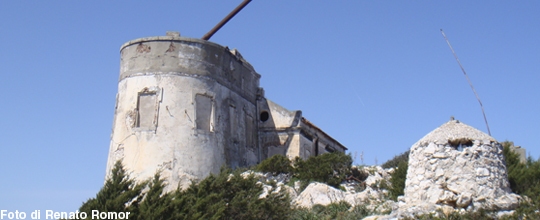

Italian Navy Radio Station
In April 1930, somewhere along the Lazio coast a group of experts, led by Guglielmo Marconi, prepared a 10 m wavelength radio electric directional beam, oriented on Golfo Aranci, where another team was working on an identical plant directed on Fiumicino. On the 23rd of May 1930 the ship Electra stopped at Golfo Aranci. For several days, Marconi's collaborator, the engineer Monachesi and his assistants, prepared the equipment necessary to complete the planned experiments. The results were exciting, but nevertheless, the scientific discoveries were questioned by an American scientist, jealous of the Italian genius. To remove all doubt, Marconi performed another important experiment between a small station that transmitted microwaves on Rocca di Pappa, near Rome and the ship Electra. Marconi boarded the Electra with a government commission, composed of eminent radio technicians, and sailed from Civitavecchia to Golfo Aranci. Maria Cristina, Marconi's wife, boarded the ship along with his assistant, the engineer Mathieu. Captain Montefinale followed the experiment on board, whilst the engineers, Isted and Gorlo, representing the Telecommunications Institute, were at Rocca di Papa. A considerable contribution to the success of the experiment was given by the experienced wireless operator of Electra, Alberto Ricciardi. ''Listening to the first signals from Golfo Aranci I noticed that the signal was notably superior to that from another area with the same wavelength that we had been working on several days beforehand. ( ....) We immediately left for Fiumicino, keeping closely in the radio beam from Golfo Aranci. The Electra was allowed to proceed at reduced speed in order to observe the beam from Golfo Aranci for an afternoon and a whole night. (....) In front of Fiumicino, the Golfo Aranci signal was defined as commercially viable." A very proud Marconi said of his achievement: "You see, once again the so-called theorists were wrong, and I, without a lot of calculations, without a lot of theories, I have shown that the micro-waves propagation is different from that of the light waves." On the 6th of August the representatives from the Italian government set sail on the route between Rocca di Papa - Golfo Aranci, Sardinia in order to study the propogation of the short waves over a relatively long distance.(....)During the crossing the broadcasts continued and the equipment and antennas were adjusted in order to obtain the best possible signal. In the darkness of the night the yacht docked at Golfo Aranci where all the equipment needed to conduct the experiment were brought to Capo Figari. The equipment was transported the next morning and installed on the terrace of the radio station at 342 m above sea level. The equipment was connected, the powered transmitters that powered the antennas were installed, and the Rocca di Papa station was asked to began broadcasting again at 16:00. ''We were greatly satisfied when the signals arrived almost immediately. The tests continued until midnight'' In conclusion: I have to say that these experiments, which have been undertaken for the first time ever have bought to light the practical applications with electrical waves which until now haven't been explored and this new technique is bound to extend the already broad scope of electrical waves to radio communications''.
The above historical data is taken from the book "Figari storie del Golfo e di Golfo Aranci" by Mario Spanu Babay. Publisher Taphros Olbia. Published in 2005. All rights reserved. May not be reproduced or distributed without express written permission from the author.